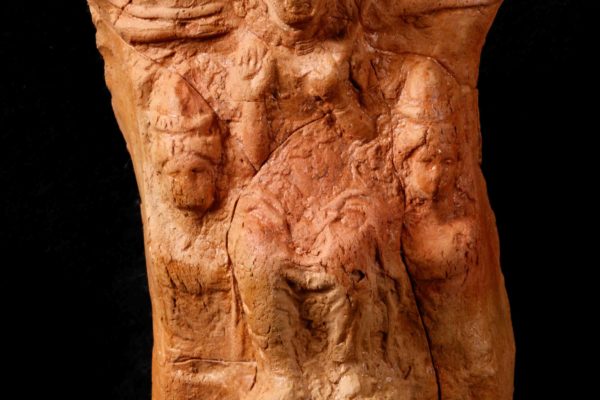Fragment of ostrich egg shell
Fragment of ostrich egg shell (525-475 BC). It is decorated by a gorgon and sphynx in relief, obtained by applying some type of acid which was later polished.
Punic- Ebusitan bowl
Punic- Ebusitan bowl with ochre remains (425-375 BC). It is one of the few known examples where a ceramic vessel has also been used as ochre container.
God Bes moulds
God Bes moulds (300-200 BC). It was probably this god who gave Ibiza its name (’Ybshm = islands of god Bes), including Formentera in this toponym also.
Jug
Jug. Local production inspired in late Hellenistic pottery from the south of Italy. It has an engraved inscription that translates as “(I) was made by Magón”.
Female head
Female head (400-300 BC). Though its face has classic features, it is profusely adorned, which is a typical Ebusitan plastic characteristic.
Funerary mask
Funerary mask (400-300 BC). Genuine Punic piece that represents a male bald head with an expressive face.
Enthroned deity Baal-Hammón
Enthroned deity (400-300 BC). Carefully elaborated piece, representing a beardless Baal Hammon, with the fenestrated ax as a symbol of the divinity.
Dea Nutrix
Dea Nutrix. (400-300 BC). Representation of the Mother Goddess. Related to an agrarian worship, incarnated by Astarte and Tanit in the Punic world.
Pendant with an astral symbol
Pendant (150-75 BC). It represents an astral symbol, similar to the Vergina Sun, emblem of the Macedonian dynasty. After the death of Alexander the Great, its use was spread across the Mediterranean.
Amulet in the shape of god Melqart’s head
Amulet in the shape of god Melqart’s head, represented as Heracles (325-200 BC). The red paint is related to the funerary ritual of closing the eyes and mouth of the corpse.
Buscar Artículos
Recent Posts
- Se presentan los vídeos del X Congreso Internacional de Estudios Fenicios y Púnicos (Ibiza, 17-21/10/2022)
- REOPENING 02/06/2020
- Un coloquio internacional analiza en Ibiza la muerte en el mundo fenicio-púnico. 26/11/2019
- El MAEF inicia el proceso de restauración de las espadas recuperadas en Es Caló, Formentera. 04/10/2019
- Video “The necropolis of Puig des Molins in Ibiza: 20 years of World Heritage”
Archives
Recent News
-

-
 REOPENING 02/06/2020 Posted on 02/06/2020
REOPENING 02/06/2020 Posted on 02/06/2020 -












Recent Comments